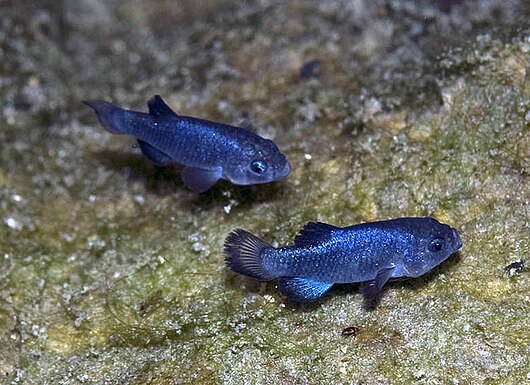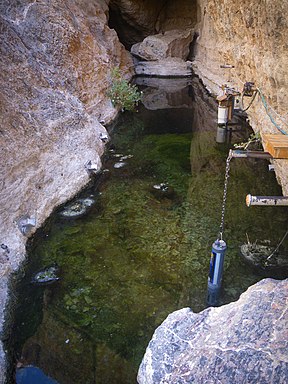Template:Especies-2019-04
Endangered species of the month
editDevils Hole Pupfish
editSome facts about this species:
Total length: 2,3 cm (♀) 3,0 cm (♂, pictured above)
Habitat: Subterraneous geothermal pools and caves with a constant water temperature of between 33.4 and 34.0 degrees Celsius.
Distribution: This lively and energetic killifish is often described as the world's rarest fish. It's range is restricted to Devils Hole,(Wikipedia) a geologic limestone formation located within the Ash Meadows National Wildlife Refuge, Nevada, in the Southwestern United States. From a single opening at the surface that is approximately 1.8 by 5.5 meters wide (pictured above), Devils Hole branches into caverns and chasms at least 90 meters (300 feet) deep.
Diet: Omnivore. They primarily feed on algae that grows on the limestone shelf in Devils Hole. The major food source during the winter and spring is Bacillariophyceae, while algae of the Spirogyra genus serve as the food source in the summer and fall. Academic autopsies have shown that at least some specimen of C. diabolis feed on small Tryonia snails as well as Dugesia triclads and tubularians.
Predators: Cyprinodon diabolis is the largest known inhabitor of Devils Hole and does not have any predators.
Surviving number: Since population surveys began, the wild population has not exceeded 553 individuals. From 1970 through 1996, the average population was 324. For reasons that are still unclear, the Devils Hole population began to decline in the mid-1990s. Since 2005, the population at Devils Hole has been below 200 individuals, although the population fluctuates depending on the season. In 2007, only between 38 and 42 fish remained in Devils Hole. In 2008, the National Park Service began to feed the pupfish a special food to attempt to restore the population. The Devils Hole pupfish count rose in the autumn of 2008 to 126, the first steady increase in more than 10 years. As of spring 2016, a periodic count found 115 of the fish living in the waters of Devils Hole.
Conservation status: Critically Endangered (IUCN 3.1), assessed August 27, 2014.
First described: By the U.S. ichthyologist Joseph H. Wales in Copeia, 1930 (no. 3): 61–70.

